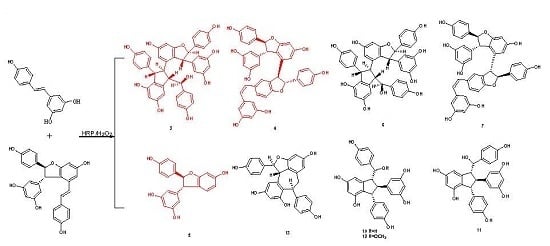Biomimetic Synthesis of Resveratrol Trimers Catalyzed by Horseradish Peroxidase
Abstract
:1. Introduction
2. Results and Discussion
2.1. Synthesis of 2 with Resveratrol as a Starting Material and HRP and Hydrogen Peroxide-Catalyzed Biotransformation of 1 and 2
2.2. Structure Elucidation of Biotransformation Products
2.3 Probable Coupling Reaction Mechanisms
3. Materials and Methods
3.1. Materials and Instrumentation
3.2. Synthesis of Compoud 2
3.3. Treatment of 1 and 2 with Horseradish Peroxidase/Hydrogen Peroxide
4. Conclusions
Supplementary Materials
Acknowledgments
Author Contributions
Conflicts of Interest
References
- Yao, C.S.; Wang, X.F. Naturally active oligostilbenes. J. Asian Nat. Prod. Res. 2016, 18, 376–407. [Google Scholar]
- Lin, M.; Yao, C.S. Natural oligostilbenes. Stud. Nat. Prod. Chem. 2006, 33, 601–644. [Google Scholar]
- Shen, T.; Wang, X.N.; Lou, H.X. Natural stilbenes: An overview. Nat. Prod. Rep. 2009, 26, 916–935. [Google Scholar] [CrossRef] [PubMed]
- Lindgren, A.E.G.; Oberg, C.T.; Hillgren, J.M.; Elofsson, M. Total synthesis of the resveratrol oligomers (±)-ampelopsin B and (±)-ε-viniferin. Eur. J. Org. Chem. 2016, 3, 426–429. [Google Scholar] [CrossRef]
- Snyder, S.A.; Gollner, A.; Chiriac, M. Regioselective reactions for programmable resveratrol oligomer synthesis. Nature 2011, 474, 461–466. [Google Scholar] [CrossRef] [PubMed]
- Snyder, S.A.; Breazzano, S.P.; Ross, A.G.; Lin, Y.; Zografos, A.L. Total synthesis of diverse carbogenic complexity within the resveratrol class from a common building block. J. Am. Chem. Soc. 2009, 131, 1753–1765. [Google Scholar] [CrossRef] [PubMed]
- Kim, I.; Choi, J. A versatile approach to oligostilbenoid natural products-synthesis of permethylated analogues of viniferifuran, malibatol A, and shoreaphenol. Org. Biomol. Chem. 2009, 7, 2788–2795. [Google Scholar] [CrossRef] [PubMed]
- Jeffrey, J.L.; Sarpong, R. Concise synthesis of pauciflorol F using a larock annulation. Org. Lett. 2009, 11, 5450–5453. [Google Scholar] [CrossRef] [PubMed]
- Snyder, S.A.; Zografos, A.L.; Lin, Y. Total synthesis of resveratrol-based natural products: A chemoselective solution. Angew. Chem. Int. Ed. 2007, 46, 8186–8191. [Google Scholar] [CrossRef] [PubMed]
- Li, W.; Li, H.; Li, Y.; Hou, Z. Total synthesis of (±)-quadrangularin A. Angew. Chem. Int. Ed. 2006, 45, 7609–7611. [Google Scholar] [CrossRef] [PubMed]
- Li, W.L.; Zang, P.; Li, H.F.; Yang, S. Biomimetic synthesis of oligostilbenes. Prog. Chem. 2012, 24, 545–555. [Google Scholar]
- Langcake, P.; Pryce, R.J. Oxidative dimerization of 4-hydroxystilbenes in vitro: Production of a grapevine phytoalexin mimic. J. Chem. Soc. Chem. Commun. 1977, 7, 208–210. [Google Scholar] [CrossRef]
- Wan, X.; Wang, X.B.; Yang, M.H.; Wang, J.S.; Kong, L.Y. Dimerization of peceatannol by Momordica charantia peroxidase and α-glucosidase inhibitory activity of the biotransformation products. Bioorg. Med. Chem. 2011, 19, 5085–5092. [Google Scholar] [CrossRef] [PubMed]
- Ponzoni, C.; Beneventi, E.; Cramarossa, M.R.; Raimondi, S.; Trevisi, G.; Pagnoni, U.M.; Riva, S.; Forti, L. Laccase-catalyzed dimerization of hydroxystilbenes. Adv. Synth. Catal. 2007, 349, 1497–1506. [Google Scholar] [CrossRef]
- He, Y.H.; Takaya, Y.; Terashima, K.; Niwa, M. Determination of absolute structure of (+)-davidiol A. Heterocycles 2006, 68, 93–100. [Google Scholar] [CrossRef]
- Wilkens, A.; Paulsen, J.; Wray, V.; Winterhalter, P. Structures of two novel trimeric stilbenes obtained by horseradish peroxidase catalyzed by biotransformtion of trans-resveratrol and (−)-ε-viniferin. J. Agric. Food Chem. 2010, 58, 6754–6761. [Google Scholar] [CrossRef] [PubMed]
- Yao, C.S.; Lin, M.; Wang, Y.H. Synthesis of the active stilbenoids by photooxidation reaction of trans-ε-viniferin. Chin. J. Chem. 2004, 22, 1350–1355. [Google Scholar] [CrossRef]
- Tanaka, T.; Ito, T.; Iinuma, M.; Ohyama, M.; Ichise, M.; Tateishi, Y. Stiblbene oligomers in roots of Sophora davidii. Phytochemistry 2000, 53, 1009–1014. [Google Scholar] [CrossRef]
- Ito, T.; Tanaka, T.; Iinuma, M.; Iliya, I.; Nakaya, K.; Ali, Z.; Takahashi, Y.; Sawa, R.; Shirataki, Y.; Murata, J.; et al. New resveratrol oligomers in the stem bark of Vatica pauciflora. Tetrahedron 2003, 59, 5347–5363. [Google Scholar] [CrossRef]
- Kim, H.J.; Saleem, M.; Seo, S.H.; Jin, C.; Lee, Y.S. Two new antioxidant stilbene dimers, parthenostilbenins A and B from Parthenocissus tricuspidata. Planta Med. 2005, 71, 973–976. [Google Scholar] [CrossRef] [PubMed]
- Syah, Y.M.; Aminah, N.S.; Hakim, E.H.; Aimi, N.; Kitajima, M.; Takayama, H.; Achmad, S.A. Two oligostilbenes, cis and trans-diptoindonein B, from Dryobalanops oblongifolia. Phytochemistry 2003, 63, 913–917. [Google Scholar] [CrossRef]
- Roger, P.; Camille, P.; Junlien, B.J.; Raffaele, T.; Kartia, G.; Oliver, V. δ-viniferin, a resveratrol dehydromer: One of the major stilbenes synthesized by stressed grapevine leaves. J. Agric. Food Chem. 2003, 51, 5488–5492. [Google Scholar]
- Pilar, R.B.; Lorena, M.C.; Jose, M.L.; Francisco, G.C. Kinetic mechanism and product characterization of the enzymatic peroxidation of pterostilbene as model of the detoxification process of stilbene-type phytoalexins. Phytochemistry 2011, 72, 100–108. [Google Scholar]
- Hirano, Y.; Kondo, R.; Skai, K. 5 alpha-reductase inhibitory compounds produced by polymerization of resveratrol with horseradish peroxidase. J. Wood Sci. 2002, 48, 64–68. [Google Scholar] [CrossRef]
- Ohyama, M.; Tanaka, T.; Iinuma, M. Five resveratrol oligomers from Roots of Sophara leachiana. Phytochemistry 1995, 38, 733–740. [Google Scholar] [CrossRef]
- Xie, J.S.; Wen, J.; Wang, X.F.; Zhang, J.Q.; Zhang, J.F.; Kang, Y.L.; Hui, Y.W.; Zheng, W.S.; Yao, C.S. Potassium hexacyanoferrate (III)-catalyzed dimerization of hydroxystilbene: Biomimetic synthesis of indane stilbene dimers. Molecules 2015, 20, 22662–22673. [Google Scholar] [CrossRef] [PubMed]
- Takaya, Y.; Yan, K.X.; Terashima, K.; Ito, J.; Niwa, M. Chemical determination of the absolute structures of resveratrol dimers, ampelopsin A, B. C, D and F. Tetrahedron 2002, 58, 7259–7265. [Google Scholar] [CrossRef]
- Keckeis, K.; Sarker, S.D.; Dinan, L. Resveratrol-type oligostilbenes from Iris clarkei antagonize 20-hydroxyecdysone action in the Drosophila melanogaster BII cell line. Cell. Mol Life Sci. 2000, 57, 333–336. [Google Scholar] [CrossRef] [PubMed]
- Takaya, Y.; Yan, K.X.; Terashima, K.; He, Y.H.; Niwa, M. Biogenetic reactions on stilbene tetramers from Vitaceaeous plants. Tetrahedron 2002, 58, 9265–9271. [Google Scholar] [CrossRef]
- Zhang, Y.; Wang, X.F.; Lin, M.B.; Hou, Q.; Yao, C.S.; Shi, J.G. Preparation of active resveratrol dimeric derivatives by oxidative coupling reaction using AgOAc as oxidant. Chin. J. Org. Chem. 2014, 34, 886–892. [Google Scholar] [CrossRef]
- Wang, X.F.; Zhang, Y.; Lin, M.B.; Hou, Q.; Yao, C.S.; Shi, J.G. Biomimetic synthesis of active isorhapontigenin dimers. J. Asian Nat. Prod. Res. 2014, 16, 511–521. [Google Scholar] [CrossRef] [PubMed]
Sample Availability: Samples of the compounds are not available from the authors. |

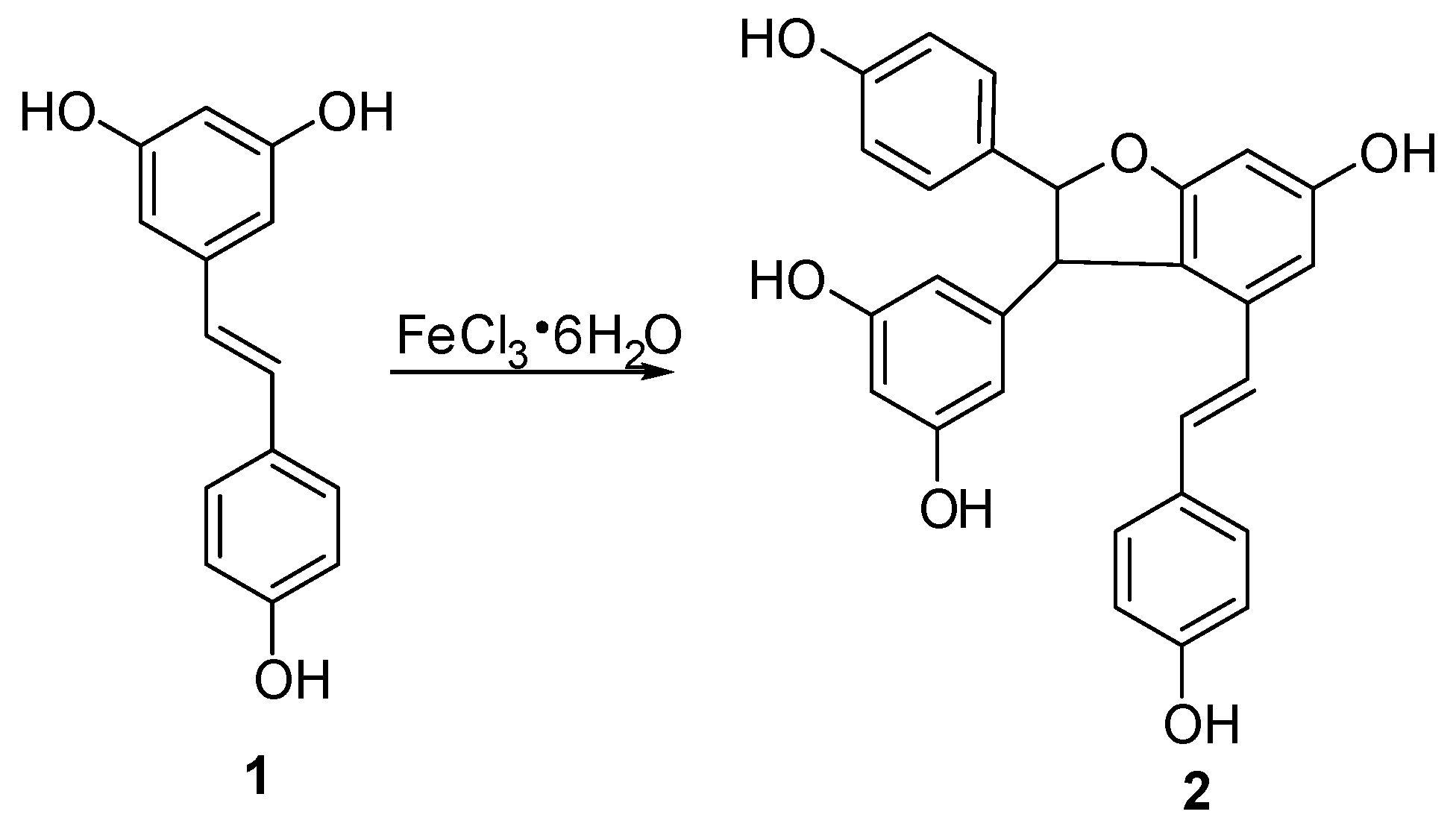
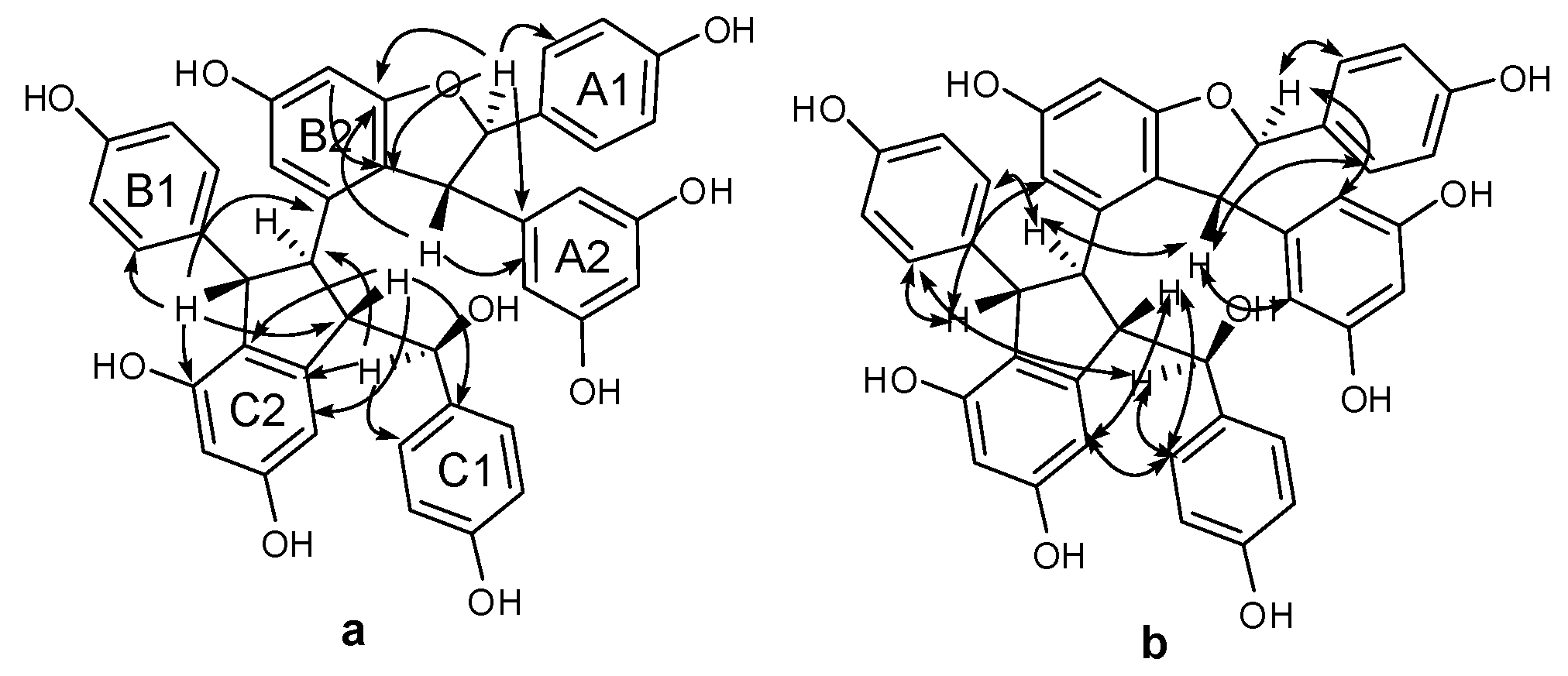
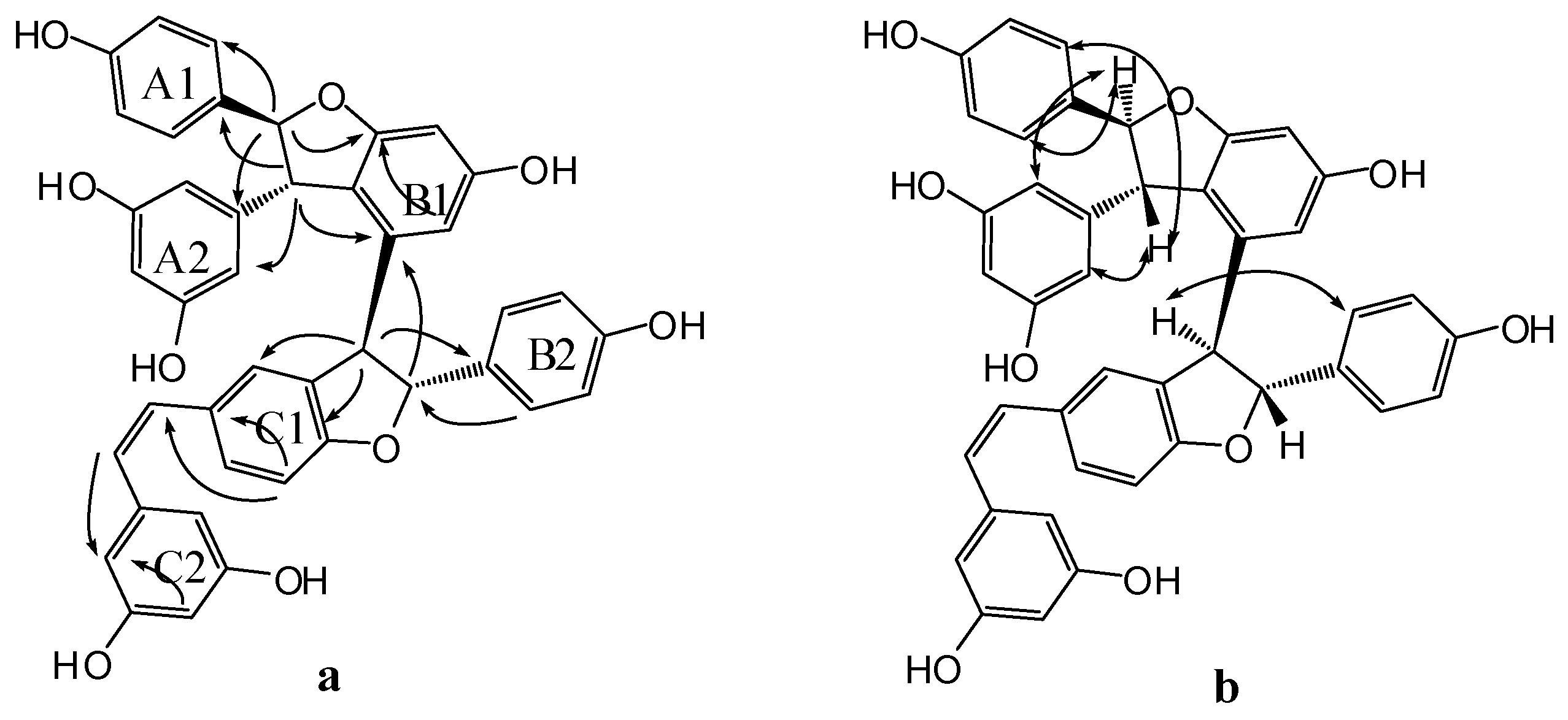
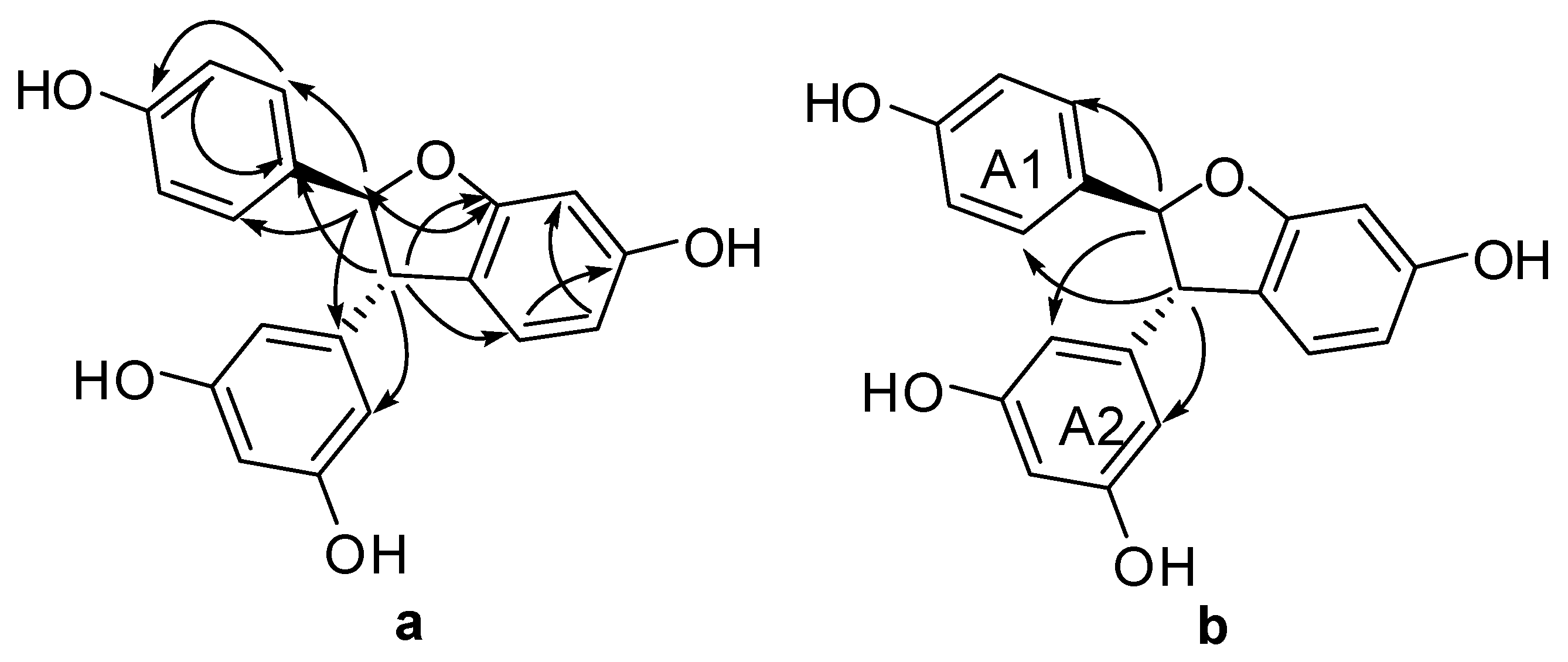



| No. | 3 | 4 | 5 | |||
|---|---|---|---|---|---|---|
| 1a | 134.69s | 133.85s | 131.98s | |||
| 2(6)a | 128.25d | 7.24 (d, 8.4) | 128.80d | 7.00 (d, 9.0) | 127.59d | 7.20 (d, 8.5) |
| 3(5)a | 116.04d | 6.83 (d, 8.4) | 116.36d | 6.80 (d, 9.0) | 115.14d | 6.82 (d, 8.5) |
| 4a | 158.11s | 158.58s | 157.36s | |||
| 7a | 93.78d | 5.33 (d, 3.0) | 95.00d | 5.22 (d, 6.1) | 92.53d | 5.34 (d, 8.3) |
| 8a | 54.73d | 4.83 (d, 3.0) | 57.8d | 3.85 (d, 6.1). | 57.66d | 4.36 (d, 8.3) |
| 9a | 149.28s | 147.28s | 144.29s | |||
| 10a | 107.13d | 6.20 (d, 2.4) | 107.27d | 5.94 (d, 2.4) | 106.51d | 6.16 (d, 2.1) |
| 11a | 159.93s | 159.56s | 158.79s | |||
| 12a | 101.82d | 6.36 (t, 2.4) | 101.90d | 6.09 (t, 2.4) | 101.34d | 6.25 (t, 2.1) |
| 13a | 159.93s | 159.56s | 158.79 | |||
| 14a | 107.13d | 6.20 (d, 2.4) | 107.27d | 5.94 (d,2.4) | 106.51d | 6.16 (d, 2.1) |
| 1b | 137.41s | 131.87s | 153.02s | |||
| 2b | 129.35d | 6.34 (d, 8.4) | 128.53d | 7.14 (d, 8.4) | 131.30s | |
| 3b | 115.48d | 6.54 (d, 8.4) | 116.30d | 6.75 (d, 8.4) | 112.10d | 6.47 (d, 2.2) |
| 4b | 155.85s | 158.69s | 151.57s | |||
| 5b | 115.48d | 6.54 (d, 8.4) | 116.30d | 6.75 (d, 8.4) | 109.08d | 6.67 (brs) |
| 6b | 129.35d | 6.34 (d, 8.4) | 128.53d | 7.14 (d, 8.4) | 114.69d | 6.67 (brs) |
| 7b | 52.64d | 4.30 (s, 1H) | 94.86dd | 5.30 (d, 8.4) | ||
| 8b | 54.45d | 3.76 (s, 1H) | 58.78d | 4.30 (d, 8.4) | ||
| 9b | 147.43s | 145.04s | ||||
| 10b | 119.71s | 120.40s | ||||
| 11b | 161.56s | 162.74s | ||||
| 12b | 95.45d | 6.19 (d, 2.4) | 96.83d | 6.23 (d, 2.4) | ||
| 13b | 159.93s | 159.48s | ||||
| 14b | 104.82d | 5.98 (d, 2.4) | 109.40d | 6.25 (d, 2.4) | ||
| 1c | 136.42s | 131.51s | ||||
| 2c | 129.22d | 6.85 (d, 8.4) | 127.36d | 6.76 (d, 2.4) | ||
| 3c | 115.33d | 6.68(d, 8.4) | 132.74s | |||
| 4c | 157.34s | 160.43s | ||||
| 5c | 115.33d | 6.68 (d, 8.4) | 109.85d | 6.65 (d, 8.4) | ||
| 6c | 129.22d | 6.85 (d, 8.4) | 130.09d | 6.98 (dd, 8.4, 2.4) | ||
| 7c | 77.10d | 4.02 (dd, 4.2, 3.0) | 131.70d | 6.21 (d, 12.0) | ||
| 8c | 65.07d | 2.96 (m) | 127.04d | 6.05 (d, 12.0) | ||
| 9c | 148.34s | 137.54s | ||||
| 10c | 123.66s | 107.71d | 6.03 (d, 2.4) | |||
| 11c | 154.66s | 159.79s | ||||
| 12c | 102.22d | 6.24 (d, 1.8) | 102.54d | 6.17 (t, 2.4) | ||
| 13c | 158.38s | 159.79s | ||||
| 14c | 106.66d | 5.17 (d, 1.8) | 107.71d | 6.03 (d, 2.4) | ||
© 2017 by the authors. Licensee MDPI, Basel, Switzerland. This article is an open access article distributed under the terms and conditions of the Creative Commons Attribution (CC BY) license (http://creativecommons.org/licenses/by/4.0/).
Share and Cite
Zhang, J.-Q.; Li, G.-P.; Kang, Y.-L.; Teng, B.-H.; Yao, C.-S. Biomimetic Synthesis of Resveratrol Trimers Catalyzed by Horseradish Peroxidase. Molecules 2017, 22, 819. https://doi.org/10.3390/molecules22050819
Zhang J-Q, Li G-P, Kang Y-L, Teng B-H, Yao C-S. Biomimetic Synthesis of Resveratrol Trimers Catalyzed by Horseradish Peroxidase. Molecules. 2017; 22(5):819. https://doi.org/10.3390/molecules22050819
Chicago/Turabian StyleZhang, Jian-Qiao, Gan-Peng Li, Yu-Long Kang, Bin-Hao Teng, and Chun-Suo Yao. 2017. "Biomimetic Synthesis of Resveratrol Trimers Catalyzed by Horseradish Peroxidase" Molecules 22, no. 5: 819. https://doi.org/10.3390/molecules22050819




